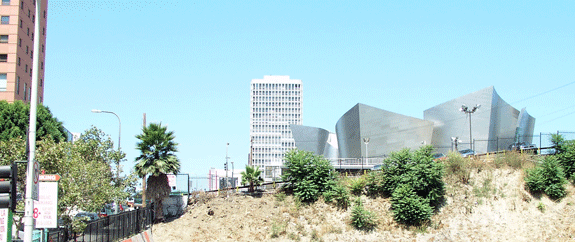
Folk will on occasion ask me what, if anything, is left of Bunker Hill. Glad you asked, I‘ll reply, answer being, nothing really, but I am awfully fond of this particular dirt contour. If they don‘t politely turn away, I‘ll commence upon a detailed discourse on said excrement-laden dirt contour in question, and then they‘ll politely turn away.
Strange as it sounds, I love this dirt. I have since I was one day idling in my auto adjacent this, the northwest corner of Second and Hill, when I saw this form and it recalled an image lodged in some dim grotto of my brain:
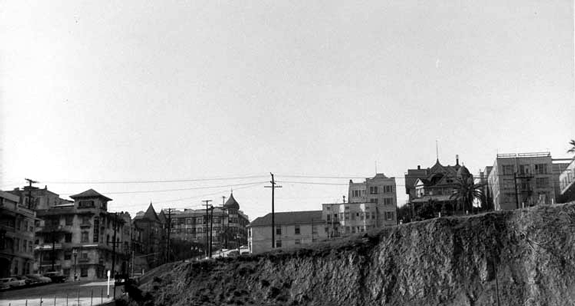
And I thought, I know that form. That contour. Like a beautiful woman in repose. Debased somehow, but still noble. Ingres‘ Odalisque has become Manet‘s Olympia.
So here I am in pith helmet and plus-fours, poking around the strangely stained abandoned sweatpants and taking in the stench of urine steaming away on a hot summer‘s day. My own Persepolis, only with more recent death and egesta. A remaining honest remnant of Bunker Hill, carved in dirt. There‘s an old Yiddish proverb–Gold‘s father is dirt, yet it regards itself as noble.
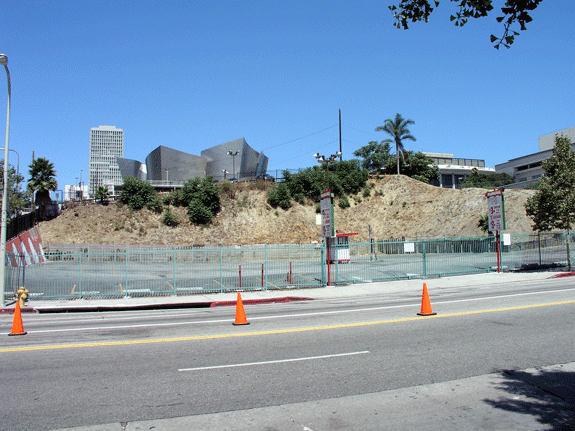
Let‘s take a detailed look at the block our patch of dirt calls home.
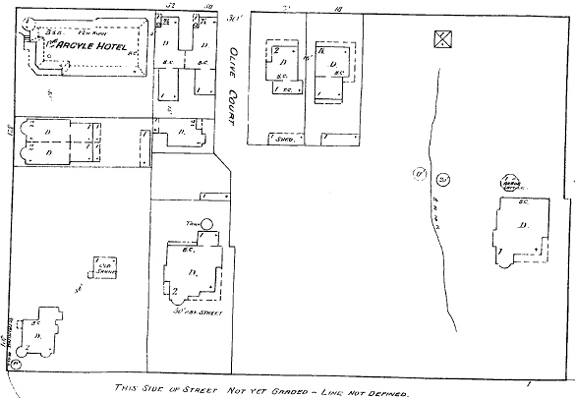
In 1888, on the 30-40′ bluff overlooking Hill there’s a large house, center, and another (with a “old shanty”, it is noted) at the corner of Second and Hill. The round structure above the house on the right reads “arbor lattice.” Note the porches on the Argyle.
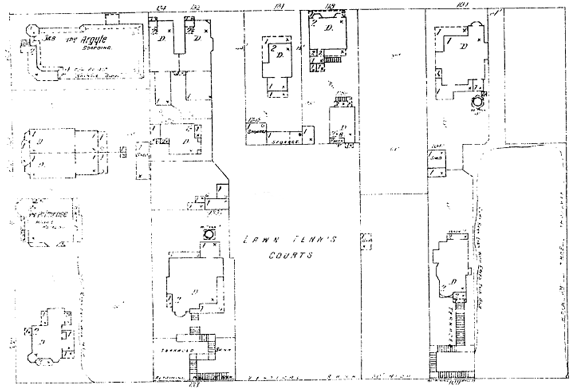
1894, and 133 Hill has built terraced steps up to its manse. Our house in the corner has sadly lost its shanty. Notice the addition of the Primrose hotel at 421/419 West 2nd. At the bottom it reads “Vertical bank 30‘ high.” The house near 1st has been razed but 109 Hill has been added. 104 Olive has shown up, top right. And yes, that says “Lawn Tennis Courts.”
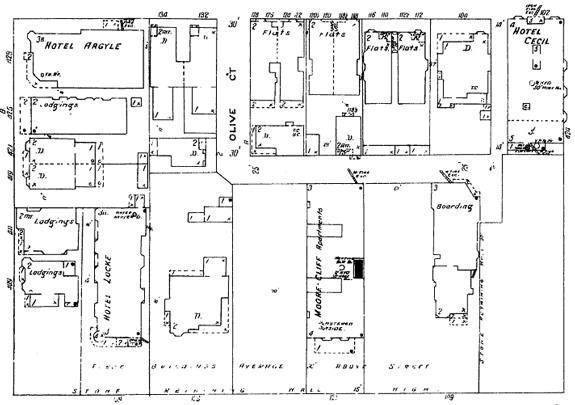
It‘s 1906, and much has changed: our little friend in the corner has disappeared. In its place, just to the north, two lodging houses at 411 and 409. To the west, Hotel Locke. (Hotel Locke shows up in the Times in 1897 and disappears in 1912.) Olive Court has wrapped around and filled in, and the tennis lawn has given way to our old friend the Moore Cliff. The former single family dwelling at 109 has been enlarged to become the El Moro Hotel. Note the Hotel Cecil in the upper right. Hill now has a 15‘ retaining wall; the houses average 30‘ above grade.
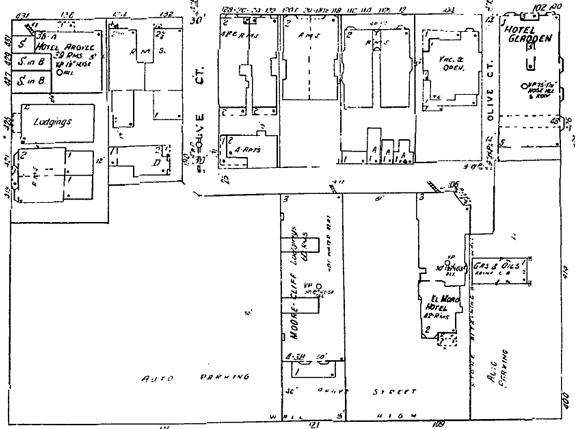
But now it‘s 1950 and the drastic has occured. Where once Second Street was sixty feet across, it is now 100, due to the construction of the Second Street tunnel, which opened in July of 1924. (As Mary mentioned in her post, the Argyle lost its porches.) Also lost were the two structures below the Primrose at 411 and 409, not to mention the Hotel Locke. These were even gone before the great excavation. The Hotel Cecil has, as you might imagine, been renamed, so as not to be confused with the Hotel Cecil. We even have a little gas station.
In a nutshell, ca. 1952: the Moore Cliff front and center, the bipartite El Moro, and the Hotel Gladden up the block in the corner. And there‘s the Texaco station that popped up. (Faithful Bunker Hillers will recognize the looming backside of the Melrose Annex and the Dome up top.)
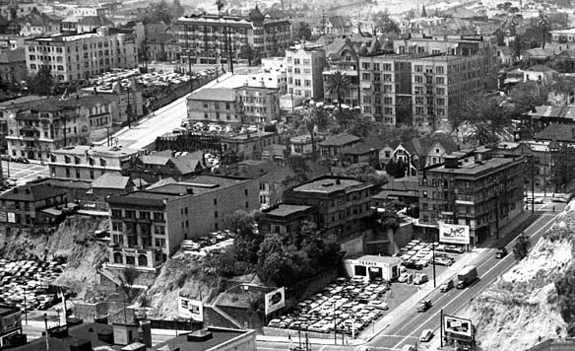
But back to the “great excavation.” Remember, once Hill had, well, a great hill looming o‘er. It was true here, at our corner in question:

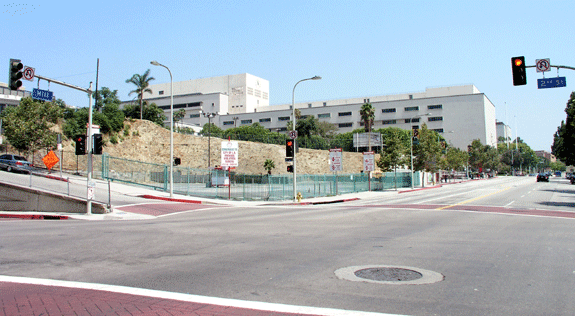
What happened to the giant pile of dirt (upon which 411 and 409, and the Hotel Locke once
sat) as seen in the 1932 photograph?

As can be barely viewed just below the Moore Cliff in the ‘32 shot, a lot fronting Hill has already been excavated for auto parking, and in May of 1935 the two adjacent lots at the corner were leveled by Los Angeles Rock and Gravel, removing 40,000 cubic yards of earth adjoining the tunnel ramp, measuring some 45hx82wx157d’. One lot owner, C. J. Heyler, rented the space to P. F. Drino for automobile parking; Heyler stated that construction on the lot was planned. That, of course, never happened.
This, then, is how we ended up with Hill carvings that have remained unchanged for seventy-three years.

And still fulfilling the same purpose.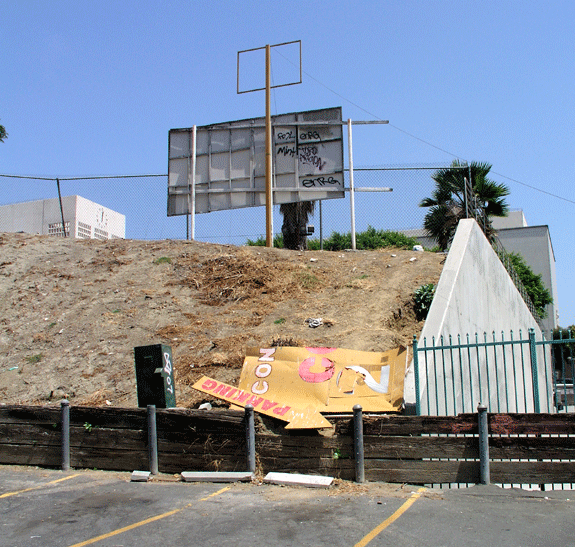
Looking southeast at our dirt, 1967, before her Hill Steet side had her top shaved off:
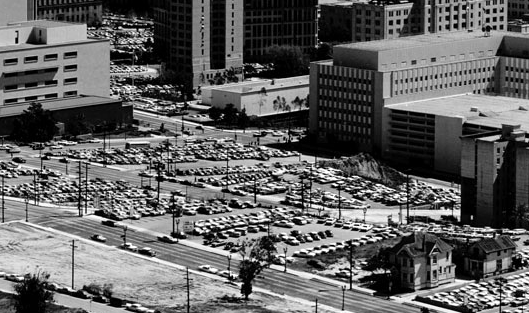
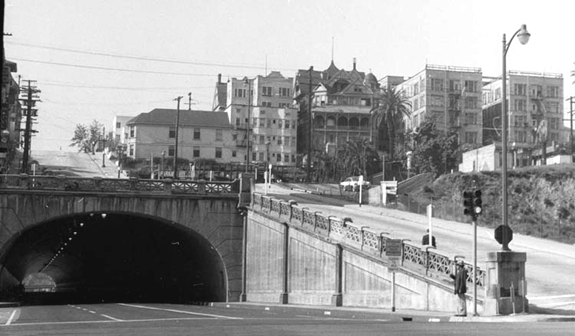
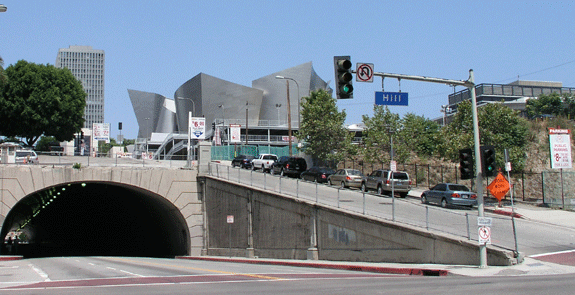
A quick word about the Second Street tunnel–with the millions the CRA is again pouring into Bunker Hill, do you think we could throw a few bucks toward a new railing? To refashion the original concrete couldn‘t run that much, and if not an aesthetic improvement, would be arguably safer than chain link. Right?
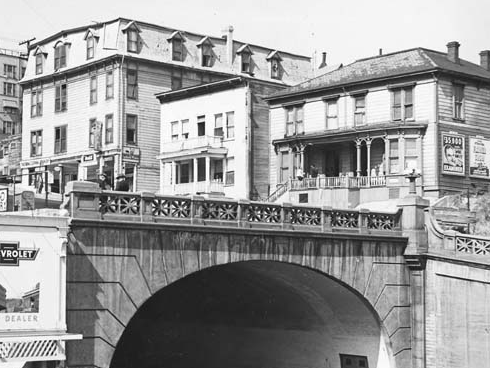
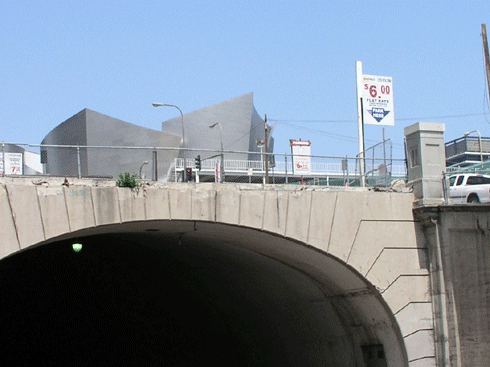
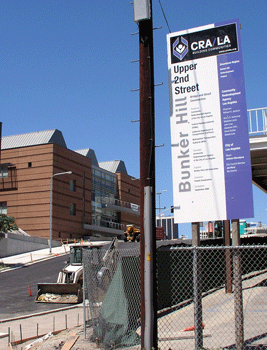
Thank you in advance for your attention to this matter.
In any event, such is the tale of some simple dirt on a single block. Tune in next week for tales of terror as they relate to this part of the world.
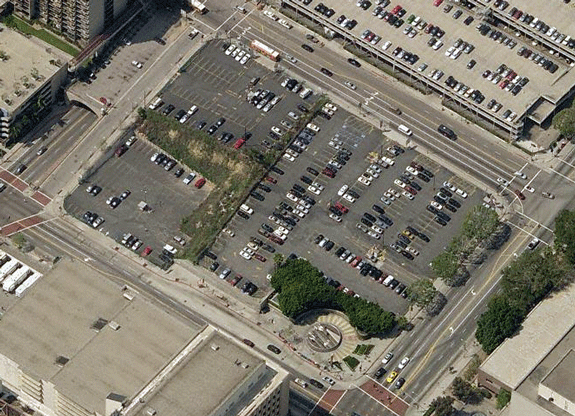
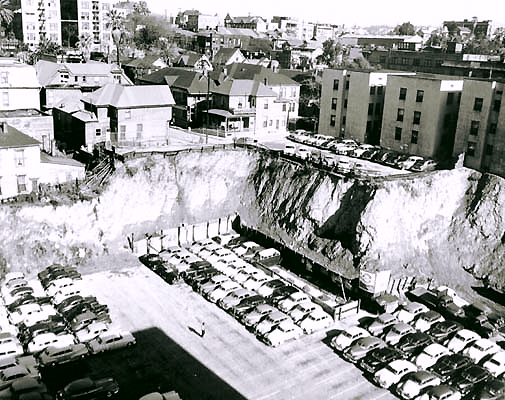
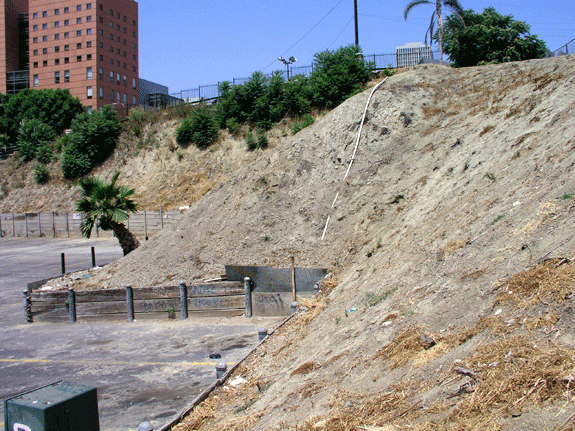
And now, you can launch into your own spiel about the dirt contours of Hill Street. I suggest a visit and have a whiff for yourself of what once was Bunker Hill. Serves to add that dose of realism guaranteeing the polite turning-away of cocktail party folk.
Images courtesy Arnold Hylen Collection, California History Section, California State Library and USC Digital Archives; special thanks of course to D. A. Sanborn, his map company, and the anonymous field men who toiled on the fire insurance maps Sanborn Co. produced.


I love your site and this post matching up the old pics with the new is amazingly thoughtful and nostalgic. Keep up the good work!!!
Nathan, by any chance do you know what the “Old Gold” sign on the dirt hill in the 1932 photo is for? I noticed a sign saying the same thing on a building on the corner of Vignes and Commercial in a 1930 Our Gang episode.
Great to see that even this smallest of recognizable remnants of Bunker Hill yet survives.
Ive driven by that pile of dirt probably 100 times in 15 years. Who would have thought that a pile of dirt could have any signifigance or history whatsoever? That was an awesome read.
Before photos, after photos, fire insurance maps, and a Yiddish proverb. Another great "On Bunker Hill" post.
I’m agog if not a little stunned but of course greatly honored by the kind words. Hey, just happy to oblige.
What to do I to top this post then? (No, besides more animated Mario Paint cartoons of Prudent Beaudry spouting Aramaic axioms while battling ninjas on Cinnabar Street.) Think I need to find a Victorian mansion somewhere in dire need of saving, and move it to the NW corner of Second and Grand. Whether I have approval from the city (or owner of the house) to do so remains to be seen.
And Chris, in answer to your question (I believe you’re referring to the Roach/MGM Pups is Pups?) Old Gold was a cigarette (…and that’s a Union Leader smoking tobacco sign behind it, and Clark is running for judge below, and dig the semaphore street light).
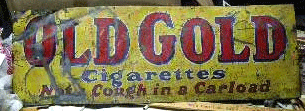
Anyone and everyone who hasn’t been down ’round Commercial & Vignes should take in a quiet spell circumnavigating Friedman Bag (now a Devon Self Storage—why that isn’t an HCM is beyond me). The area bounded by Commercial, Vignes, Center and Jackson was where the giant gas tanks once stood (roughly, there were three, with one east of Center St.), you know, the ones you always see in old images of downtown looming behind City Hall. The Southern California Gas Company tank that was 375’ high was especially impressive.
Anyway, again, thanks for the appreciative comments and I know I speak for all the OBH bloggers when I say we’ll do our best to further delight in bigger and better ways. Excelsior!
Thanks, Nathan, it was in fact Pups is Pups! So Old Gold was a cigarette brand.
In this screen cap of that scene you can also see the tanks in the background:
This is fantastic. There oughta be a book.
Scroll up a bit to the shots of Second where it rises above Hill—and now feast your eyes on
We have the glory of the Cushman Collection to thank for this one.
I mean, 421/419 is blue! Blue!
And I have a hankering for some delicious Brew 102!
There are those time travelers who busy themselves with the study of wormhole metrics and subsequently spend uncountable dollars and manhours building impossibly complicated machines (e.g., the doohickey from last week’s “1909” post). Then there are those who, bastard descendents of Richard Collier, simply will themselves to be. Back then.
J. L. Ordaz is one such gent. He can remove the embarrassing signifiers of contemporary society and project himself into the past, and document himself there and then. Spiritual heir to McDermott/McGough, if you will.
In being who he is, he gets to go to places others might not. While area youth drive to and from places extreme, Bailey is so not her handbag, and Justin takes it to the next level, and Caitlin’s tongue piercing is giving her trigeminal neuralgia, but Ordaz is out altogether somewhere else, ambling through dilapidated backwood buildings, treating himself to things abandoned, both physical and metaphysical.
On the physical plane, he found some photos.
Which he so kindly put up on Flickr for the world to enjoy and benefit from. The first to raise an eyebrow was the Bunker Hill home of the Bradburys. That caught my eye right off; I squinted at a couple others until that a-ha moment.
For there it was, two images of the north side of Hill Street, taken from atop the tunnel at First.
I wrote Mr. Ordaz and asked if he’d be kind enough to allow me to reproduce them here; he is. For that I thank him. I’ve also tinkered and tailored and soldiered and spied on these pics in an effort to bring the image detail into somewhat clearer focus:
In the foreground of course are the El Moro and the flattened face of the the Moore Cliff. I’m most fond of the rounded tower, center/left, which I believe to be the Hotel Locke, before that whole side of the block was excavated for auto parking. One gets a feel for how mammoth the retaining walls were. And off in the distance, the tower at upper right is the Astoria.
Thanks again to Mr. Ordaz for his generosity in allowing my use of these images, for his posting them on Flickr, and for finding them in the first place, of course.
I just wanted to say what a great site you have here. Looking through all these fascinating old photos inspired me to create a simple overlay of the east 2nd St tunnel entrance. Enjoy. I hope to do more of these. Time permitting.
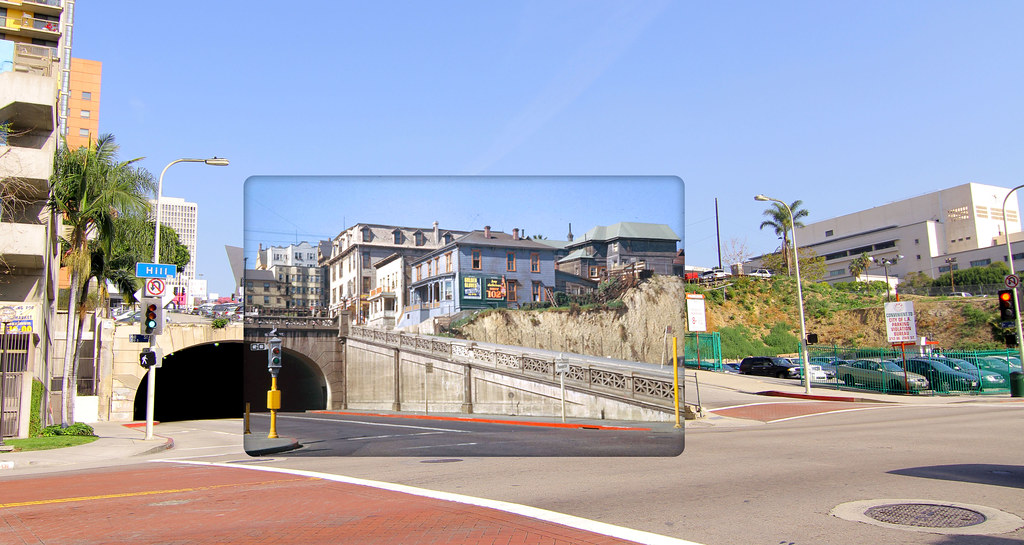
We appreciate your sharing this striking image, and would love to see more. Just FYI, I scaled your image down to a size that fits within the borders of this site layout–if you do post others, a width of about 500 is just right. Feel free to include a link to see your larger pictures on Flickr and comment on them there. Here’s the link for the page with your tunnel overlay photo on Flickr.